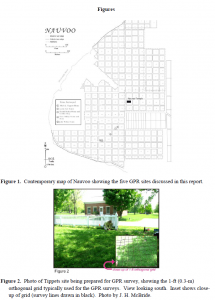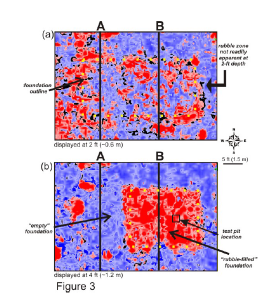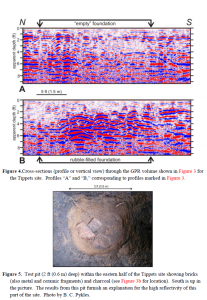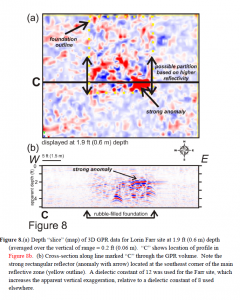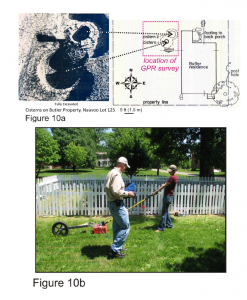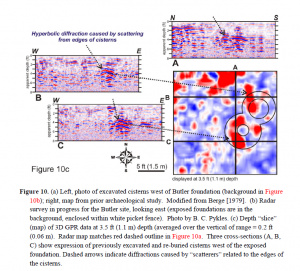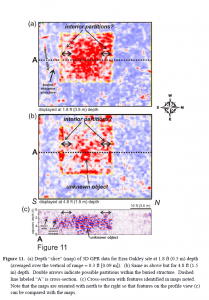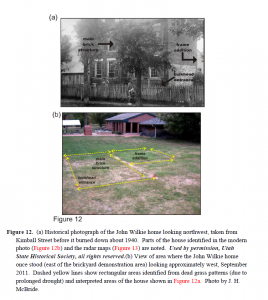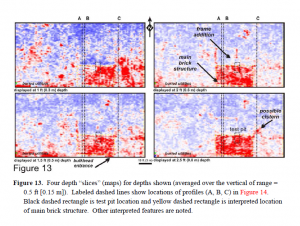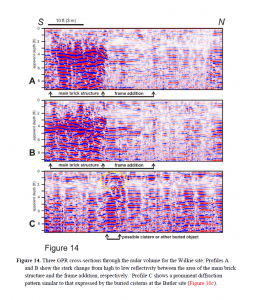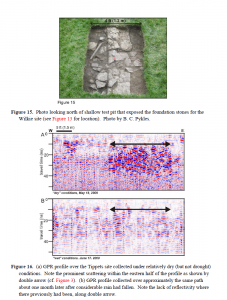FINAL REPORT
BYU Mentoring Environment Grant
“Assessing the Archaeological Resources of Mormon Nauvoo with Three-dimensional Geophysical Imaging”
Project period: January 1, 2012 through January 31, 2014
Submitted by Prof. John H. McBride
June 13, 2014
Executive Summary:
Evaluation of how well the academic objectives of the proposal were met
The principal objective of the project was to provide BYU students with the experience of exploring Nauvoo using ground-penetrating radar (GPR) in order to gain a better appreciation of early Mormon history from a geophysical and archaeological perspective. The objective was met by carrying out two field seasons in Nauvoo. In addition, the grant partially funded a field expedition to the LDS Far West Burying Grounds and Hawn’s Mill sites in Missouri in order to perform surveying work analogous to that performed in Nauvoo. Additional funding for this project was provided by the LDS Church History Department, which allowed more field seasons and supported increased student and faculty/staff participation. During the project period, results were presented at the annual conference of the Mormon Historical Association and one scholarly article published in Mormon Historical Studies.
Evaluation of the mentoring environment
BYU students worked closely with BYU faculty and staff on site in Nauvoo during two field seasons (Sept. 21-29, 2013; May 28-June 5, 2012). Students also interacted in Nauvoo with Dr. Benjamin C. Pykles, Historic Sites Curator, LDS Church History Department and Lachlan E. MacKay, Historic Sites Coordinator for Community of Christ.
During these two field seasons, students performed ground-penetrating radar (GPR) geophysical surveying and analysis under the direction of Prof. John McBride (lead PI on the MEG project). Dr. Pykles and Ryan Saltzgiver (M.S. student in BYU Archaeology; hired on the MEG) supervised students’ work with test-pit excavations at sites where GPR data were collected. The general procedure was for students to receive training on the historical background of a particular 1 archaeological site (e.g., the Theodore Turley Home site), presented in the broader context of the Mormon history of Nauvoo; then receive training on the use of the GPR instrument; perform GPR surveying of the site; review the results of the survey; use the GPR results to strategically locate areas for test pits (e.g., where there was a suggestion of a buried archaeological feature); receive instruction on the method and use of test pits (e.g., how to methodically remove soil and catalog artifacts); proceed with digging test pits; review results with supervisors; review how the test pits confirmed (or not) interpretations from the GPR.
While in the field, students also were given specialized study tours of several sacred sites in Nauvoo and Carthage (including sites on LDS and C of C properties). These tours were conducted by Dr. Pykles, Mr. Saltzgiver, and Mr. MacKay and went well beyond the usual “tourist” experiences. For example, students received a detailed tour and explanation of the Red Brick Store and its significance to LDS history and doctrine. Students were housed and took most meals in the historic Nauvoo House. This property is owned by the Community of Christ. Mr. MacKay has graciously provided the house, free of charge, to visiting BYU students as part of this MEG and other BYU or LDS Church History Department projects.
In some cases, if travel routes to/from Utah permitted, students also toured sites of historical and sacred interest in Missouri (e.g., Far West, Hawn’s Mill, Adam-ondi-Ahman).
An additional field season was added, with partial financial and logistical support from the LDS Church History Department, in west-central Missouri (Aug. 8-12, 2012) at the LDS Far West site. The archaeological objectives of this activity were similar to those in Nauvoo, except that the primary targets were grave sites (Far West Burying Ground) dating from the 1830s. Although no graves were confirmed from the efforts of this field season, we did test a methodology based on surveying large swaths of an agricultural field followed by trenches dug with a back-hoe, augmented by chemical sampling of soil for phosphate concentrations.
List of students who participated and what academic deliverables they have produced or it is anticipated they will produce
Allied faculty, staff, students, professionals who acted as supervisors or field assistants:
Prof. John McBride, Geological Sciences
Prof. David Tingey, Geological Sciences
Prof. Bill Keach, Geological Sciences
Lachlan E. MacKay, Historic Sites Coordinator for Community of Christ
Dr. Benjamin C. Pykles, Curator, Church Historical Sites, LDS Church History Department
Ms. Kristine Mortenson, Administrative, Geological Sciences
Ryan Saltzgiver, M.S. Student, BYU Anthropology
BYU Student Participants:
Sept. 21-29, 2013 Nauvoo surveying trip:
John Yaede
Ryan Saltzgiver
Scott Greenhalgh
Spencer Campbell
Rae Jacobsen
Aug. 8-12, 2012 Far West surveying trip:
Jessica Williams
Trevor Tuttle
Brian Selck
Emily Keller
John Boyle
May 28-June 5, 2012 Nauvoo surveying trip:
Matt Randall
James Moore
S. Johnson
Karli Sparling
Michelle Meadows
Jesse Sheridan
Sarah Gunnell
Brian Selck
Jeff Valenza
Kat Robertson
Katie Anderson
Quincy Nickens
Ryan Saltzgiver
One student (Ryan Saltzgiver) expressed strong interest to participate in writing a scholarly article. Mr. Saltzgiver wrote the historical part of the article by McBride et al. (2012b). He is also now working on a second article, to be submitted to the archaeological literature, on the specific results from the Theodore Turley Home site in Nauvoo, briefly summarized below. This article will involve additional student authors who participated in the MEG project.
Description of the results/findings of the project
Note: the following text is extracted with some modification from the published article by McBride et al. (2012b). Some of the results reported herein pre-date the MEG project period, but are included in order to provide a broad context and for the sake of completeness. Lastly, some of the final results of the MEG project are only briefly summarized here (e.g., Turley site results); a fuller account of such results are in the processed of being prepared for publication.
Introduction
The overall layout of the historic Mormon city of Nauvoo has been known for many years. Extant maps from the Mormon period (1840’s) illustrate the city’s division into four-acre lots. Tax and property records from the same period, moreover, have long since shed light on the actual owners of numerous Nauvoo lots and the various structures built throughout the city. What is lacking, however, is an understanding of where these structures were located within the specific city lots and what remains of the internal features of original Mormon sites that have long since disappeared from the landscape.
Our study summarizes the results of a program to test the application of three-dimensional ground-penetrating radar (3D GPR) for locating and understanding the buried archaeological resources of the 1840’s Mormon settlement of Nauvoo. This advanced, non-intrusive technology allows for the detection and visualization of foundations and related architectural features that survive beneath the surface of the earth today. The information resulting from this project has the potential to facilitate and guide future restoration projects in the historic city and ensure that development does not unintentionally disturb the buried resources of Nauvoo. If GPR exploration can answer questions about the archaeological resources lying buried in Nauvoo, we could use this technique to non-invasively guide our understanding of the dimensions, locations, and internal composition of historic Nauvoo structures that are no longer standing. These answers could, in turn, aid our understanding of the city’s growth and decline, and shed some insight into the conditions under which the settlers lived.
Physical Description of the Nauvoo Study Site
Nauvoo is located along the western edge of what geologists call the “Till Plains Section of the Central Lowland Province,” where the rugged topography expressed as bluffs following the Mississippi River contrasts with the subdued, undissected terrain of ancient glacial deposits lying immediately to the east (Figure 1).i This area is mantled by glacial sediments (commonly known as “drift” or “till”), beneath which bedrock is deeply buried. Previous authors, writing from a civil engineering perspective, have described the surficial geology and soil composition for Nauvoo and the immediately surrounding area.ii On the basis of coring observations, Rollins et al. constructed a soil profile that showed fine-grained sediments thinning from 16 ft (4.9 m) at the foot of the Bluff to only 2 ft (0.6 m) near the river’s edge where limestone bedrock is exposed in places. Visitors to Nauvoo only need venture as far as the old quarry, from which the stone was extracted for the original Nauvoo Temple, to see how thin the soil can be. Here the limestone bedrock is actually exposed at the ground surface. The soil overlying bedrock elsewhere in Nauvoo variably consists of a few feet of dark clay, silt, and occasionally some sandy deposits, as observed by borings made by Rollins et al. and encountered by our test pits at several sites (see Results below). Such fine-grained materials (clay and silt) are expected for a swampy environment, whereas the sandy layers were likely deposited in higher-energy sedimentary environments, including streams that emptied into the main channel of what is now the Mississippi River. As pointed out by Rollins et al., some of the clay is likely the product of the weathering of the limestone bedrock. Because clay and the underlying limestone have low permeabilities, rainfall tends to infiltrate slowly, flowing horizontally as surface runoff. iii Anyone engaged in the business of excavating for new building foundations in the Flats of Nauvoo will likely discover that the water table can be very shallow, sometimes just below, or even at, the ground surface.
How GPR Works and What Makes a Good Target
Locating buried archaeological remains, such as building foundations and interior structures, was one of the earliest uses of GPR. iv Archaeological applications of GPR for understanding building sites broadly range from studies relevant to classical civilization in the ancient world v to more arcane sites of relatively recent historical interest.vi The technology has previously been utilized in archaeological applications at other church historic sites including Kirtland, Harmony, Far West, and at the original Provo Tabernacle site. In most instances, GPR imagery has provided valuable data for assessing extent subsurface features and assisted in more efficient planning for excavations conducted at those sites.vii.
Three-dimensional (3D) GPR surveys move an antenna across the ground in a series of closely spaced lines (in our case, usually spaced 1 ft [0.3 m]) running parallel and perpendicular to the expected orientation of possible buried structures, such as a buried foundation wall, so as to produce an orthogonal grid. The antenna both transmits and receives electromagnetic (EM) signals that reflect off or are scattered by dense or metallic objects and that are recorded by a specialized computer connected to the antenna. Antennas with various center frequencies may be used, depending on the depth and size of the target. For archaeological applications, a 400-MHz antenna, as employed by our study, is typical. Computer processing of the recordings generates a “volume” of radar reflectivity that can be sliced vertically or horizontally, producing cross-sections or subsurface maps, respectively, that reveal buried objects.
Because the reflected GPR signal arrives at the antenna over time (a typical recording time is 100 nanoseconds [ns]), the images must be converted to depth using an assumed or derived EM velocity for the soil overlying the target.viii Stone or brick foundations, demolition rubble, and interior walls are examples of buried remnants that could reflect EM energy. Such materials have electrical properties (known as dielectric constantix) that contrast markedly with the surrounding soil. A buried limestone foundation, derived from local bedrock, is composed mostly of calcium carbonate (CaCO3) and has a reflectivity that varies markedly from that of soil. This is largely because limestone has a lower porosity relative to soil. The speed of EM energy is much greater in air than in solid limestone.x This means that we expect a strong radar reflection from a foundation composed of limestone or other solid material (e.g., brick). A strong signal may also be a diffraction from a “scatterer”, which is expressed as an upward convex pattern (mathematically, a hyperbola) on a radar profile.xi
The strength of any received signal also depends on absorption of energy by the medium through which the signal travels as well as on the depth of the target. Water in the pore spaces of the soil (or stone) attenuates EM signals. Fine-grained materials (clay or silt) are also destructive to the signal. As reviewed above, the soils of Nauvoo, especially on the Flats, are dominated in places by fine-grained sediments, which are frequently moist (or even water-logged). The presence of clays and wet conditions thus combine to make Nauvoo a challenging environment for GPR studies. Our results show that best performance of GPR is possible under dry conditions xii.
Results
In order to investigate the utility of GPR in Nauvoo, we conducted surveys over a range of differing archaeological targets related to the 1840’s Mormon period: buried foundations, cisterns or wells, hidden pavements or floors, and concentrations of debris associated with the demolition of buildings. Sites on which both brick and frame structures once stood were surveyed. We began our process of selecting sites by consulting research based on tax records; lots that were associated with higher property tax payments were deemed more likely to hold substantial buried archaeological remains (e.g., a stone foundation that once supported a brick structure). Here we present results from five known 1840’s Mormon sites that demonstrate how varying targets can be imaged: (1) the Alvah L. Tippets home, (2) the Lorin Farr home, (3) the Daniel Butler home and cobbler shop, (4) the Ezra Oakley home and store, (5) the John Wilkie home (Figure 1). The GPR surveys were conducted at different times of the year and under different soil moisture conditions. Our results show how and under what conditions such archaeological targets can be studied using GPR. Further, 3D computer visualization techniques were applied and deemed necessary in order to detect the subtle GPR anomalies that are typical of the archaeological resources in Nauvoo.
Alvah L. Tippets House
The Alvah L. Tippets site, located along Munson Street just east of the Heber C. Kimball home (Figure 1), was chosen for our first radar test because previous archaeological testing had suggested where the foundation of a building might lie, buried beneath what is now a grassy lawn with no signs that a structure ever existed (Figure 2)xiii Limestone foundations and evidence of rubble-filled rooms had been reported from test trenches. Berge reports that the Tippets house was demolished prior to the beginning of the twentieth century, described in the Nauvoo Independent as an “old brick house…an old Mormon landmark.”xiv
Alvah L. Tippets, the owner of the home on the west quarter of lot 4, block 106, first came in contact with the Church in 1832 when Jared Carter was preaching the restored gospel in Lewis, New York. Shortly after his baptism, Tippets was called to preside over the branch in Lewis. Tippets appears to have remained in Lewis, presiding over the Church there during the troubles in Missouri. By 1842, however, he had relocated to Nauvoo. On April 29 of that year, Tippets purchased the property in block 106 from Randolph Alexander. While living in Nauvoo, Tippets was called upon to sit on many important committees including the committee seeking redress from Missouri,xv and as an agent of the Temple committee to collect tithes. xvi There is evidence to suggest that Tippets did not live in his Nauvoo home for very long. An affidavit sworn 20 June 1844 lists Tippets as living just south of Nauvoo in Warsaw, Illinois.xvii On 24 October 1847, at the age of 38, Alvah L. Tippets passed away at Winter Quarters. Unfortunately, there is little documentary evidence to suggest what the Tippets’ Nauvoo home looked like, although Berge asserted that it was likely similar to the nearby Winslow Farr home. Brick rubble found atop the foundation during exploratory archaeological work conducted at the site indicates that it was likely a brick structure though no evidence was found to suggest the building had a basement.
The GPR survey was conducted in May 2009, after a moderate rain had fallen the previous week. For this and all sites studied, we chose our survey area large enough so that any anomalous pattern could be viewed in a context where archaeological features were absent. Horizontal depth slices through the volume were generated by binning the data into a 3D grid and then interpolating the data over a narrow depth range. Volume rendering was also performed xix for this site by reducing the general gain of the volume so as to accentuate only the highest amplitudes. Relatively shallow depth slices (horizontal maps) through the GPR volume show the outline of a rectangular shape, which is defined by patchy, discontinuous lines of moderate reflectivity (Figure 3a). We interpret this pattern to be remnant buried foundation walls. The patchy character likely represents a wall that is uneven and missing parts of its original stone. As we slice deeper into the site (i.e., produce horizontal maps from deeper intervals), a remarkably solid pattern of strong reflectivity appears within the eastern part of the buried structure (Figure 3b), precisely filling the foundation outline there. Vertical views (i.e., profiles or cross-sections) cutting through the eastern and western parts of the rectangular volume (Figure 4), within the reflective and unreflective portions, respectively, show different patterns. The eastern profile shows pronounced reflectivity below about 2.5 ft (0.8 m) consisting of strong scatterers (diffractions) down to about 7 ft (2.1 m), whereas the western profile shows no internal reflective structure.
Our initial interpretation of this reflective versus non-reflective pattern was that the eastern part of the buried structure was filled with small objects (as evidenced by abundant diffractions), whereas the western part was devoid of any objects that could scatter the signal. Our hunch was that the eastern half once had a cellar that is now filled with building rubble (i.e., bricks and other building material or rubbish). In order to test this idea, we first augered test holes in the two areas. In the western area, we immediately encountered small fragments of red brick, but were able to easily penetrate to 4.5 ft (1.4 m) without refusal; however, while augering in the eastern half (where reflectivity was high), we only managed to penetrate less than half that depth (2.1 ft [0.6 m] before stopped by rigid material. We then dug a 2 x 2 ft (0.6 x 0.6 m) pit over this hole, finding a 1-ft (0.3-m) layer of dark, clayey soil underlain by lighter sandy soil. At 2 ft (0.6 m) depth, red bricks, brickbats, and fist-sized limestone fragments appeared (Figure 5). These features confirmed our initial interpretation that the strong reflectivity in the eastern part of the structure was caused by building rumble used to fill only one side of the structure. Other objects recovered from the test pit included animal bones, metallic can pieces, small ceramic fragments, hand-forged and machine-cut nails, bits of charcoal, and miscellaneous metallic fragments. Such objects are consistent with an interpretation that the cellar area was used for a rubbish dump following the demolition of the house. Our survey thus shows clear evidence of a cellared structure to the east, confirming Berge’s hypothesis.
The reflectivity patterns associated with foundation walls and interior structure are first-order features of the radar data; however, second-order features, the interpretation of which is less straight-forward, are also visible. For example, a rectangle of higher reflectivity, about 5 ft (1.5 8 m) long and at a depth of about 2 ft (0.6 m) appears just south of the foundation on the eastern side of the structure (Figure 3a). Looking at the deeper slice (Figure 3b), this anomaly defines a gap in the southern boundary. While a unique interpretation is not possible without excavation, explanations include a buried door stoop or bulkhead entrance. Door stoops composed of tooled limestone blocks are known from surviving structures, historic photographs, and from archaeological excavations of 1840’s Mormon homes in Nauvoo.xx
We learn from studying this site that it is possible to achieve a high level of detail with GPR surveys in Nauvoo. One can see variations in reflectivity that relate to internal partitions and in the degree of rubble within a building. During demolition, it is probable that building material (bricks, portions of a stone foundation, glass, etc.) gets pushed into the interior where it is then covered with soil laden with smaller debris. Such may account for the strong, but scattered and poorly coherent, reflectivity that appears within and actually defines the buried structure, even when a discrete foundation is not clearly defined. The effect of rubble defining the limits of a buried structure has also been noted by archaeologists working in Nauvoo. For example, Berge, in referring to the difficulty locating a buried wall at the Tippets site, states “It was assumed that the wall ended where the rubble ended.”xxi No representation of the exposed Tippets site (either from excavation or an historic photograph) is available; however, the foundation exposed at the Community of Christ-owned Times and Seasons site, at the intersection of Water and Bain Streets (Figure 6), is possibly analogous to what underlies the Tippets site. As can be seen from Figure 6, the Times and Seasons site is divided into two sections, the one on the south being an open foundation (once a cellar), lined with stone and containing (or once containing) rubble, while the section to the north is a shallow stone foundation without a cellar.
Lorin Farr House
The Lorin Farr House, located on Block 106, Lot 4 (Figure 7), was torn down after the turn of the twentieth century.xxiii This site is located along the west side of what was originally Durphy Street (now State Highway 96). Lorin Farr, son of Winslow and Olive Farr, was a personal friend and bodyguard to the Prophet Joseph Smith. After joining the Church in 1834, the Farr family relocated from their home in Waterford, Vermont to Kirtland, Ohio in 1838 to be nearer the main body of the Saints. By that time, however, Church headquarters—and the Prophet—had relocated to Western Missouri. Wanting to meet the prophet, Lorin, in company with his brother Aaron, left his family behind and walked the 1,000 miles to Far West to meet the Prophet. After arriving in Missouri, Farr became a friend of the Smith family, a guest in their home, tutor to their children, and eventually accompanied the family through the persecutions of Missouri. While Joseph Smith was imprisoned in Liberty Jail, Farr carried letters between Smith and his wife. When the Church—and the Prophet—relocated yet again to Nauvoo, Farr joined them there.xxiii Soon after, Winslow Farr, his wife, and most of his children also relocated to Nauvoo. Winslow purchased a half-acre plot on the eastern half of lot 4, block 106 along Durphy Street in Nauvoo. While the property was never officially subdivided and ownership was never transferred from father to son, Winslow and Lorin Farr built two brick homes, approximately 17X23 ft (5.2X7.0) each, constructed in the federalist style. xxiv During the time the Saints occupied Nauvoo, Lorin Farr served missions in Connecticut, Wisconsin, Illinois, and the “middle and eastern states.” xxv. When he was not serving missions, Farr was a frequent laborer on the Nauvoo temple.
Exactly when the Lorin Farr home was built is unclear, however, the Farr family were prolific in building activities. In addition to the two homes on lot 4, block 106, Lorin and Winslow Farr built a “stone and adobe house” elsewhere during one of Lorin’s breaks between mission activities.xxvii. Lorin Farr married Nancy B. Chase on January 1, 1845 in a ceremony performed by Brigham Young. Shortly after, the young couple began making preparations to leave Nauvoo. According to Lorin Farr’s son John, William Clayton penned a trail guide for those leaving the city while visiting Farr in his home. xxvii. After settling in Utah, Lorin Farr was called by Brigham Young to settle in Ogden where he was made the first president of the Weber Stake. Farr also served as the first mayor of Ogden for many years.
Because the area of the Farr home was swampy when the Mormons first arrived, a long canal was dug along the east side of Durphy Street, the remains of which can be seen today.xxviii As part of an archaeological report on Block 106, Berge states that the Lorin Farr house was relatively small and constructed of brick with a limestone foundation. A full-scale excavation of the site was not undertaken, but a preliminary set of exploratory trenches were dug in an attempt to understand the site’s archaeological resources.xxix Our GPR survey was designed to be identical to that for the Tippets site, and generated a series of horizontal depth slices (Figure 8a) and vertical views (Figure 8b).
The Farr site GPR survey had the advantage of being conducted under extremely dry conditions near the end of an extended drought (September 2011). The results for the Farr site (Figure 8a and 8b) differ considerably from those of the Tippets site. First of all, the GPR depth maps for the Farr site show a discrete border, interpretable as buried foundation walls, surrounding a rectangular pattern of reflectivity that corresponds to the plan drawn by Berge. Similar foundation walls are not as clearly imaged for the Tippets house (Figure 8a).xxx Conversely, although divisions may be seen within the buried structure at the Farr site, as suggested by square or rectangular patches within the radar maps (e.g., Figure 8a), these are not nearly as well-expressed as similar features seen in the maps for the Tippets site (Figure 3b).
The most interesting result from the Farr site was the expression of a well-defined rectangle of strong reflectivity (Figure 8a) in the southeast corner of the survey area. The well-defined edges of the anomaly, combined with its perfectly flat expression on vertical profiles (Figure 8b), attests to a buried feature with a flat, smooth surface. After processing the 3D GPR data, we subsequently located the exact area of this anomaly and dug a small 2 x 2 ft (0.6 x 0.6 m) pit that revealed a section of remarkably smooth brickwork rimmed on the west side of the pit by a short 10 section of a curved brick wall, apparently two bricks high (Figure 9). The same or a similar feature was described from preliminary archaeological explorations by Berge and was interpreted as a possible section of a fireplace.xxxi Artifacts were recovered from the soil above the brickwork in the base of the pit and included brick and limestone fragments, cut nails, glass, and fragments of earthenware ceramics, similar to what we found at the Tippets site.
The results of our surveying and excavation at the Farr site, when compared to our efforts at the Tippets site, demonstrate the variation in radar expression for two brick houses dating from the 1840’s and demolished at roughly the same time (late-nineteenth or early-twentieth century). The Farr site also provides an example of how an unusual and historically interesting feature hidden beneath the soil can be mapped precisely without a full-scale excavation.
Daniel Butler, Jr. Home and Cobbler Shop
The Daniel Butler, Jr. site is located on Block 125, Lot 3 East of Main Street, on the north side of Parley Street (Figure 1). On 18 December 1843, Daniel Butler, Jr. purchased the eastern third of this lot in the Nauvoo plat.xxxii. Butler appears to have been a merchant and a member of the Church from Massachusetts who for a time rented and operated Joseph Smith’s Red Brick Store with his partner P.B. Lewis (Smith 1842-1844). Some evidence indicates that Butler may have operated a cobbler shop and dry goods or general store from his property on Parley Street. xxxiii. Other evidence indicates that Butler, along with his partner, P.B. Lewis, accompanied Addison Pratt on the first leg of his journey to the Pacific Islands. Neither Butler nor Lewis completed the journey although Lewis apparently paid for the passage of Pratt and his three companions to Tahiti. Butler, on the other hand, appears to have left the Church when the group stopped in New Bedford, Massachusetts, Butler’s home town xxxiv. In July 1845, an ad in the Nauvoo Neighbor announced that Butler’s home and “one third of a lot of Parley Street east of Main near Mr. Oakley’s” was for sale. The home, as advertised,was 20 by 30 ft (6.1 X 9.1m) and two stories high. xxxv. The property eventually sold for $200 to William Jones in May 1846. xxxvi. According to local tradition, Butler’s home on Parley Street survived long into the twentieth century, about 1940, it burned when a kerosene stove exploded inside. xxxvii.
Following its destruction, the Butler property remained undisturbed until archaeological excavations commenced in the 1970’s, by which time, the brick and mortar rubble around the foundations had been invaded by wild vegetation, all of which had to be cleared prior to starting excavations. While excavating the site, archaeologists uncovered two buried cisterns, possibly used for culinary purposes, located west of the northwest corner of the main structure. (Figure 10a). The two cisterns are superimposed, the northern and most recent one being constructed within and partially destroying the other. The northern cistern was a maximum of 6.3 ft wide (1.9 m) and extends to a total depth of (2.1 m). The older southern cistern was 5.82 ft (1.77 m) wide with a total depth of 4.21 ft (1.28 m). Although both cisterns had basically the same shape and construction material (brick and cement or heavy mortar), the southern one had been partially dismantled to a deeper level exposing the vertical edges (Figure 10a), while the northern cistern was buried less deeply. Following the archaeological study, the cisterns were reburied. The foundations of the main structure remain exposed today as part of an exhibit of an early Nauvoo structure (Figures 10a and 10b).
The GPR survey for the Butler site (Figure 10b) was conducted one day following the Tippets site survey, so the ground was still moist. In order to test the ability of GPR to detect complex 3D structures like buried cisterns, we conducted a survey immediately west of the main structure, using Berge’s map as a guide (Figure 10a).xxxviii From the standpoint of radar imaging, a roughly spherical or cylindrical object made of brick or stone that is either hollow or filled with soil (and thus having a contrast in dielectric constant) is expected to present a complex target. “Slicing” the 3D radar volume in Figure 4 at a depth of 3.5 ft (1.1 m) and superimposing the outline of the two cisterns shows two areas of high reflectivity that correspond to the cisterns. Vertical slices through the 3D volume (Figure 10c) show strong, isolated diffractions at depths indicated by Berge for the upper parts of the buried cisterns. Further, the southern cistern shows more prominent scattering than does the northern one. Diffractions from the southern cistern (Figure 10a) arrive from a slightly greater depth. The above observations are consistent with a pair of buried objects, one of which (southern) is deeper with sharper edges (because it had been partially dismantled).
This exercise, surveying a known but complex target, demonstrates how GPR can detect and map buried cisterns or geometrically similar 3D objects. Although test excavation, guided by radar, are required to verify a cistern (or other) interpretation, explanations of anomalies such as these can also be constrained by spatial context, as most cisterns are expected to be located near a corner of a house.
Ezra Oakley site
The Ezra Oakley site is located on Block 125, Lot 3 immediately west of the Butler site (Figure 1). Like the foregoing study areas, the Oakley site was chosen for GPR survey because it had been referenced and marked during earlier archaeological investigations.xl And like the other Nauvoo sites we have studied, no remnant of a structure was visible at ground level, other than a ghostly outline of dead grass brought on by severe drought. Several decades ago, Berge noted a similar effect during “a long dry spell.”xli
Prior to joining the Church in 1841, Ezra Oakley, a veteran of the War of 1812, had made a modest living as a merchant in his native Brooklyn, New York. After arriving in Nauvoo in 1843, Oakley purchased a third acre plot in the eastern half of Lot 3, Block 125 in Nauvoo from Joseph Smith.xlii On this property, Oakley built a two-story home and store. His general store also served as the office of the Nauvoo Tannery. xliii. Oakley was a successful merchant and member of several professional guilds in Nauvoo. In fact, he was so successful that his store became, quite literally, a landmark in the city. Advertisements in the Nauvoo Neighbor frequently referred to the subscriber’s location relative to “Mr. Oakley’s Store” (i.e., the 1 October 1845 edition of the Nauvoo Neighbor in which three advertisements cite Oakley’s store as a landmark). Oakley sold the property to William Allen on 15 April 1846 shortly before he and his family departed the city and headed west. Oakley’s daughter, Mary Ann, became the fourth wife of apostle and future Church president John Taylor. As a result, the Oakley family traveled west as members of the John Taylor Company. It is not known when the Oakley home and store was later demolished.
Although some rain had fallen during and prior to the survey, drought conditions prevailed (October 2011) and the ground remained relatively dry. Of all the sites discussed thus far the Oakley site was the highest quality for radar with considerable detail in the maps and cross-sections. Shallow depth slices (0.67 ft [0.2 m]) (Figure 11a) reveal a more clearly defined outline than the Tippets and Farr sites. This outline is interpreted as a foundation wall, recognizable as diffractions on vertical views through the volume (Figure 11a). Along the western part of the roughly square outline, a sub-division with a rectangular outline (long dimension parallel to the street) can be defined that may represent an individual room or masonry partition. Near the southwestern corner of the structure a small rectangular feature appears on depth slices just outside the main outline, which could be interpreted as a small stoop or cellar entrance (Figure 11a). Vertical views confirm isolated objects that could be buried paving stones or other reflective objects. Looking deeper within the main structure, one can see a roughly rectangular area of concentrated high reflectivity, as well as a clearer definition of the foundation walls (Figure 11b). Reflectivity for the main structure dissipates at a depth of about 4.6 ft (1.1 m).
A shallow test pit (2 x 4 ft [0.6 x 1.2 m]) was dug within the approximate center of the western half of the structure to a depth of 14 inches (0.36 m). A heavy concentration of artifacts was encountered immediately beneath the sod, much more so than the sites discussed above. Artifacts were varied and included many sizes of cut and wire nails, earthenware fragments, glazed brick pieces, glass, wire, charcoal, and coal, all of which indicate the structure’s cellar hole had been used as a trash dump for some time after the building was destroyed. Deeper excavation was not undertaken at this time.
The Oakley site is a good example of how a strong delineation of the boundary of a buried building is given by GPR maps. This site also shows reflectivity variations in the interior of the main structure (e.g., area of reduced reflectivity parallel to Parley Street) and on the exterior of the structure (e.g., stoop or entrance facing Parley Street) that can guide an archaeological strategy for an excavation or simply non-invasively interpreting a site.
John Wilkie Site
The John Wilkie site is Block 119, Lot 4 and is immediately east of Nauvoo’s brickyard demonstration area on the north side of Kimball Street, between Hydexliv and Partridge Streets (Figure 1). The site is covered by a flat, well-tended lawn, which at the time of the survey (early June 2012) was green and somewhat moist from recent rainfall; however, during a previous inspection of the site during a drought in October 2011, rectilinear outlines of dead grass could be seen.
John Wilkie and his wife Catherine suffered through the persecution of the Saints in Missouri. When the Church moved to Nauvoo, the Wilkies followed, continuing in their desire to be near the Prophet. When Joseph Smith announced his desire to purchase the steamboat Des Moines from Robert E. Lee, Wilkie was among the first to support the ill-fated venture. After the steamboat, renamed Nauvoo, ran aground and sank, Joseph Smith owed over $73,000 in outstanding debts, $2,700 of which he owed to Wilkie (Oaks and Bentley 1976).xlv The situation was so dire that Joseph Smith was forced to declare bankruptcy leaving many, including Wilkie, unable to recoup their funds. Wilkie, understandably, struggled as a result of this situation. Despite his personal loss, however, he continued to live among the Saints at Nauvoo. In 1843, he purchased a two-story brick home from two enterprising citizens, William E. Horner and Abraham Hoover, who appear to have built the home with the intention of selling it for a profit. Despite remaining in the city, Wilkie continued to struggle with the principles of the gospel, particularly tithing. In March 1844, he requested a personal audience with the Prophet Joseph Smith. During the meeting, which took place in Wilkie’s home, Joseph Smith explained the importance of a consecrated life and blessed the home. At the conclusion of the meeting, Wilkie gave $300 in gold and silver coin to the Prophet to support the construction of the Nauvoo Temple; xlvi, the source of Wilkie’s substantial financial assets is not known. After Joseph Smith was killed, the Wilkies remained in Nauvoo, choosing not to follow Brigham Young west. John’s wife, Catherine, was later recorded among the adherents to the teaching of James J. Strang.
The Wilkie site was one of the higher quality GPR sites surveyed and showed the greatest detail. Further, our interpretation of the results is guided by a historic photograph (Figure 12a), taken at an angle oblique to Kimball Street, allowing for independent verification of important details of the structure. Further, the severe drought in September 2011 caused the grass over the buried house foundations to die, revealing the general outlines of the structure’s footprint (Figure 12b). This site showcases how GPR can reveal distinguishing features at differing depths by displaying radar maps over a range of depths, on which diverse patterns appear. At a depth of 1 ft (0.3 m) (Figure 13), a rectangle of patchy reflectivity appears with its long dimension almost exactly parallel to Kimball Street. A distinct north-south line of reflectivity appears exactly in the middle, which also defines a subtle change in the intensity of the reflectivity from west to east, with the eastern half being slightly more reflective than its counterpart. This partitioning of the rectangle into two squares may be related to the symmetrical division of the brick home’s 14 front façade as seen in the historic photograph. Other areas of rectilinear reflectivity are also visible at this depth, such as a distinct area a short distance to east of the main rectangle.
A slightly deeper radar map at 1.5 ft (0.46 m) depth (Figure 13) reveals a distinct outline enclosing the rectangular zone of high reflectivity, which we interpret as a stone foundation. By analogy with the foregoing sites, such as the Tippets and Oakley sites, we interpret the strong reflectivity enclosed with the distinct outline to represent rubble collapsed into the interior of the main brick structure. At this depth, one can now also see a thick band of reflectivity extending north from the west boundary of the main structure for about 12 ft (3.7 m). On depth maps from 2.0 and 2.5 ft (0.6-0.8 m) (Figure 13), additional lines of distinct reflectivity north of the main brick structure suggest an approximately square feature, but with no pronounced internal reflectivity like that seen in the main brick structure. This square outline is interpreted to represent the frame addition to the rear of the home, a corner of which appears in the historic photograph (Figure 12a). As expected, north-south cross-sections that span the area of the main brick structure and the frame addition in the rear (profiles A and B, Figure 14a) show a strong pattern of reflectivity for the former area and a non-reflective pattern for the latter. Finally, the square outline north of the main brick structure (Figure 13), which shows no strong internal reflectivity, is interpreted to represent the frame addition, a corner of which appears in the historic photograph (Figure 12a).
With increasing depth, the reflectivity within and around the main structure becomes stronger, but also more variable. A patch of reduced reflectivity appears along the northern border of the west half of the main structure. At the same time, a small circular concentration appears just off the northeastern corner of the main structure. We suggest that this feature represents a possible buried cistern, positioned with respect to the main structure so as to collect rainwater. This possible cistern shows a diffraction pattern similar to that observed for the confirmed cistern expression on radar images from the Butler site, discussed above (cf. Figures 10c and 14b). At approximately 3 ft depth (0.91 m), another distinct rectangle of high reflectivity appears along the southern border of the main structure, appended to the southeast corner. We interpret this small rectangular feature to be the footprint of the bulkhead entrance into the cellar beneath the main brick structure.
The day after we conducted the radar survey and examined the processed radar results, an exploratory test pit was dug (Figure 15) over the boundary between the two varyingly reflective halves of the main structure. The pit revealed a thick north-south line of limestone foundations with smaller pieces of rock on either side, which corresponds with the line of reflectivity dividing the two halves seen on the GPR depth map. Due to time constraints in the field, additional test pits were not excavated to verify the interpretation of the other features seen on the radar depth maps (e.g., the possible cistern).
Theodore Turley Site
Turley is believed to have built the first structure (a log cabin) in Nauvoo after the Mormons arrived on Block 147, Lot 4. He also apparently built a brewery on this property; there was an advertisement for the brewery in one of the Nauvoo newspapers on 27 Dec. 1843. An old photograph depicts a brick structure, with a frame (?) addition on back, believed to have belonged to Turley. Initial GPR testing on this site suggested features and rooms not detected by previous archaeological testing in the 1960’s. During the last field season in Nauvoo, we concentrated considerable effort on surveying this site with GPR, followed by digging of several test pits. Our results indicate that this site has the highest degree of heterogeneity of radar targets (e.g., buried cisterns, walls, collapsed cellars) of any site studied by us so far. The Turley site results will be the subject of an article prepared for the archaeological literature, led by BYU student Ryan Saltzgiver.
Discussion and Conclusions
The five archaeological sites we surveyed demonstrate the diversity of GPR targets that are likely to be associated with Mormon Nauvoo. Our results give specific examples of how GPR surveys can pinpoint features of particular interest and guide archaeological excavations or development, in order to minimize disturbance of an archaeological site or make a major excavation more efficient. The maps and cross-sections derived from GPR reveal some of the architectural elements and related features that an archaeologist can expect to find in the course of an excavation in Nauvoo.
The Tippets site shows how GPR can delineate distinctly different areas expressed by the strength of signal scattering, in this case a highly scattering area juxtaposed with an area of no scattering. The strong variation in radar scattering was verified, through test excavation, to be directly related to bricks and other rubble that had been placed in one section of the structure, but not in the other. This areal variation effectively divides the interior of the buried foundation into two partitions or rooms, the eastern section having a cellar. Knowledge about the buried partitioning of the building, and about the solid material (in this case, bricks and rubble) within the partitions is valuable to archaeologists intending to excavate this or a similar site. In some parts of the Tippets site, foundation walls are not well-preserved, but may be inferred by the lateral cessation in reflectivity related to interior rubble. Other Nauvoo sites we studied (e.g., Lorin Farr site) also showed this effect. In contrast, the Wilkie site shows well-preserved foundation walls expressed as a distinct outline of reflectivity that encloses a highly scattering rectangular area, which was also confirmed by test excavations.
The Farr site provides a case where the main footprint of the structure is defined by a rectangular patch of weakly scattered radar signal, but also includes a small, discrete, rectangular area of enhanced reflectivity that was confirmed by test excavations to be a neatly intact section of smooth brickwork. The exceptionally strong reflectivity of this target, together with its rectangular outline, suggest to an archaeologist that a buried object with a flat surface lies buried within the overall structure and deserves further study or strategic excavation.
The Oakley site provides a good example of GPR’s capabilities under ideal conditions (in this case, extremely dry soil and reduced vegetation). The GPR maps for this site allow the archaeologist not only to see a high degree of scattering, indicating interior rubble (like that seen at the Tippets site), but also the exact location of discrete foundation walls at deeper levels. The quality of the image is such that subtle interior partitioning is visible, as well as the remains of a front step or bulkhead entrance.
A three-dimensional (3D) target (i.e., a feature that does not merely follow one or two directions, like a wall or area of buried brickwork) is considerably more difficult to image with GPR, especially if it is small compared to the signal wavelength. The most common 3D archaeological targets expected for buried 1840’s buildings in Nauvoo include privies, wells, and cisterns. The GPR survey adjacent to the excavated Butler foundation indicates that buried cisterns can be detected; however, due to their complex shape and small size, they are expressed mainly as a concentration of strong scatterers with an overall circular outline in map view. Understanding what kind of pattern to expect for such a feature alerts the archaeologist to the possible presence of such delicate, complex structures prior to commencing an excavation.
The Wilkie site shows the most detail of all those surveyed for this project, including a set of foundation walls expressed on the radar maps as distinct rectilinear features. These walls enclose varying intensities of the radar signal, which likely represent variations in the amount of rubble-filled space beneath the main brick part of the building (located to the south, facing the street) and a frame addition (attached to the rear of the main brick structure on its northwestern corner). This site also gives us the best example of how GPR can reveal a small buried structure attached to the main building, in this case a bulkhead entrance into a cellar, as seen in a historic photograph. Several other features appeared on the radar maps that need to be explored with strategically placed test pits in order to verify their meaning (e.g., a possible cistern, like those at the Butler site).
Lastly, in order to demonstrate the critical importance of dry conditions for successful GPR imaging, we collected single profiles across the Tippets site before and after a significant rainfall (respectively, May 2009 and June 2009). Figure 16 shows the before and after profile that cuts through the center of the site. The results speak for themselves; the intense radar scattering that so clearly delineates the separate partition shown in Figure 16 is difficult or impossible to see after the rain. The increase in electrical conductivity caused by the infiltrated rainwater together with the presence of clays has dramatically attenuated the radar signal. It is thus essential to conduct GPR surveys under dry soil conditions.
Summary
Ground-penetrating radar (GPR) has been tested over a three-year period (2009–2011) in old Nauvoo at over 20 sites owned by The Church of Jesus Christ of Latter-day Saints and by The Community of Christ. Most of these sites date from the 1840’s Mormon period. Several of these sites were surveyed to produce 3D images of the upper few feet of the subsurface, the results of which are presented herein. Interpretation of the 3D GPR images was guided by test pits, shallow auger holes, prior archaeological excavations, historical photographs, and contextual information gleaned from historical documents such as newspaper articles or ads. The results of the GPR testing demonstrate the ability to detect and map buried foundation walls, interior partitions, cisterns, small structures attached to the main building (e.g., a bulkhead entrance or small stoop), and zones of rubble or other unknown material within a building foundation. The remains of some buried structures frequently produce intense internal reflectivity (“scattering”), in places with only a weak expression of discrete foundation walls. In other cases, internal scattering is less well expressed. The degree of internal scattering appears to be related to the history of the structure following abandonment (e.g., after abandonment, the structure was filled with rubble or rubbish, versus filled with soil). The tests conclusively prove the applicability of GPR for assessing the archaeological resources of Nauvoo, while indicating the limitations imposed by varying soil moisture and clay content. Further, our results suggest a means by which large areas of the Flats of Historic Mormon Nauvoo could be non-invasively assessed for archaeological resources. Such an assessment could allow both churches to inventory their properties for buried architectural remains, prior to any planned development or further archaeological excavations.
Description of how the budget was spent
The total allocated budget for the MEG was $19,305.00.
Supplies:
Batteries for GPR recording unit: $278, March 2012; $302.46, Aug. 2013
Transportation:
Airfare for participants traveling to Nauvoo: $5,721, April 2012 Airfare for R. W. Keach, II, May 2012: $430.58
Food, lodging, gasoline, supplies expenses while traveling:
Nauvoo, Sept-Oct, 2013: $1,273.25; $131.63; $128.38
Nauvoo, Aug 2012: $681.65; $18.55
Nauvoo, May 2012: $589.62
Nauvoo, May-June 2012: $3,308.19
Nauvoo, Sept-Oct, 2013: $1,823.66; $31.00 Far West, MO, Aug 2012: $886.72
Nauvoo, June 2012: $1,313.50 (groceries for group)
Shipping:
$20.85, June 2012; Boxes: $183.29
To Nauvoo: $252.86, April 2012
Wages for Ryan Saltzgiver:
$581.30 Aug 2012; $960.00 June 2012; Benefits $44.19 Aug. 2012
June 27-July 1, 2012 Presentation at MHA Conference on Nauvoo project:
MHA registration: $150
Expenses in Calgary: $44.57, $747.59 June 2012
Printing costs: $500
TOTAL COSTS: $20,402.84
Published works arising from the MEG project
McBride, J. H., Pykles, B. C., Keach, R. W., II, and Smith, R. A., 2012a, Assessment of Archaeological Resources in Old Nauvoo Using Ground-Penetrating Radar, Mormon History Association Conference, Calgary, Alberta, June-July, 2012. http://www.mormonhistoryassociation.org/cms-assets/documents/73727-997292.2012-final-program.pdf
McBride, J. H., Pykles, B. C., Saltzgiver‡, R. W., Richard‡, C., and Keach, R. W., II, 2012b, Challenges and triumphs of ground-penetrating radar for studying the archaeological resources of Mormon Nauvoo, Mormon Historical Studies, vo. 13, nos. 1-2, p. 161-197. http://mormonhistoricsites.org/mormon-historically-studies/
___________________________________________________________________________________
i David L. Reinertsen and John M. Masters, A Guide to the Geology of Dallas City Area (Champaign, IL: Department of Energy and Natural Resources, Illinois State Geological Survey, 1987).
ii John S. Nealon, “‘Morning Fair, Roads Bad:’ Geology, Topography, Hydrology, and Weather on the Iowa and Nebraska Mormon Trails, 1846-1847,” Nauvoo Journal [Mormon Historical Studies] 10, no. 1 (Spring 1998): 67–95; Kyle M. Rollins, Richard D. Smith, M. Brett Borup, E. James Nelson, “Transforming Swampland into Nauvoo, the City Beautiful: A Civil Engineering Perspective,” BYU Studies 45, no. 3 (2006): 125–157.
iii Rollins et al., “Transforming Swampland into Nauvoo, the City Beautiful.”
iv Lawrence B. Conyers, “Ground-Penetrating Radar for Archaeology,” in Geophysical Methods for Archaeology, 149–159 (Walnut Creek, CA: AltaMira Press, 2004).
v See Salvatore Piro, Dean Goodman, and Yukio Nishimura, “The Study and Characterization of Emperor Traiano’s Villa (Altopiani di Arcinazzo, Roma) Using High-Resolution Integrated Geophysical Surveys,” Archaeological Prospection 10, no. 1 (2003): 1–25; Sergio Leucci and Giovanni Negri, “Geophysical Investigation of the Temple of Apollo (Heirapolis, Turkey),” Journal of Archaeological Science 33, no. 11 (2006): 1505–1513.
vi Lewis E. Hunter, Allan J. Delaney, and Daniel E. Lawson, “Investigation of the Roosevelt Road Transmitter Site, Fort Richardson, Alaska, Using Ground-Penetrating Radar,” US Army Corps of Engineers Cold Regions Research & Engineering Laboratory, Report 99-4, 1999; Abbas M. Abbas, Hiroyuki Kamei, AmerHelal, Magdy A. Atya, and Fathy A. Shaaban, “Contribution of Geophysics to Outlining the Foundation Structure of the Islamic Museum, Cairo, Egypt,” Archaeological Prospection 12, no. 3 (2005): 167–176; Jean-Phillippe Boudreault, Jean-SébastienDubé, Michael Chouteau, Thierry Winiarski, Éric Hardy, “Geophysical Characterization of Contaminated Urban Fills,” Engineering Geology 116 (2010): 196–206; John H. McBride, Benjamin C. Pykles, Emily Utt, and R. William Keach, II, “Rediscovering Provo’s First Tabernacle with Ground-Penetrating Radar,” BYU Studies Quarterly 51, no. 2 (2012): 61–77.
vii John H. McBride, Benjamin C. Pykles, Emily Utt, and R. William Keach, II, “Rediscovering Provo’s First Tabernacle with Ground-Penetrating Radar,” BYU Studies Quarterly 51, no. 2: 61–77.
viii Conyers, “Ground-Penetrating Radar for Archaeology”; A.P. Annan, ”Electromagnetic Principles of Ground-Penetrating Radar,” in Ground Penetrating Radar: Theory and Applications, edited by H.H. Jol, 4–40 (Amsterdam: Elsevier Science, 2009).
ix John Milsom, Field Geophysics, 3rd Edition (New York: Wiley, 2003); Annan, “Electromagnetic Principles of Ground-Penetrating Radar.”
x Annan, “Electromagnetic Principles of Ground-Penetrating Radar.”
xi Diffractions indicate an object that is relatively small, with respect to the wavelength, such as a building stone or brick. A diffraction may also emanate from a sharp edge, such as the border of a buried brick pavement. Because the wavelength for our antenna when applied to the soils found in Nauvoo is expected to be about 1 ft (0.3 m), objects with a longest dimension much less than 1 ft are expressed as a scatterer of radar signal. For this study, a general dielectric constant of 8 was usually found to be close to optimum in order to match objects of a known depth with the depth-converted radar image; however, changing soil and moisture conditions between sites and during different survey dates (our study spans three years) means that the depth conversion is not always be totally accurate. For simplicity, a dielectric constant of 8 is used unless otherwise noted.
xii Milsom, Field Geophysics.; Conyers, “Ground-Penetrating Radar for Archaeology”.
xiii Dale L. Berge, “Preliminary Archaeological Explorations at the Lorin Farr, Alvah H. Tippets, and Stillman Pond Sites, Block 106, Lot 4, Nauvoo, Illinois,” [Nauvoo, IL]: Nauvoo Restoration, Inc., 1971.
xiv Ibid.
xv Nauvoo Neighbor, 12 June 1844
xvi Nauvoo Neighbor, 29 October 1845
xvii Latter-day Saint Millennial Star, 26:245
xviii Berge, “Preliminary Archaeological Explorations at the Lorin Farr, Alvah H. Tippets, and Stillman Pond Sites.”
xix B.J. Kadlec, H.M. Tufo, and G.A. Dorn, “Knowledge-assisted visualization and segmentation of geologic features” IEEE (Institute of Electrical and Electronics Engineers) Computer Graphics and Applications 31, no. 1: 30–39, doi:10.1109/MCG.2010.13, 2010.
xx Dale L. Berge, Archaeology of the Daniel Butler, Jr. Property, Nauvoo, Illinois (Salt Lake City, UT: Nauvoo Restoration, Inc., 1979).
xxi Berge, “Preliminary Archaeological Explorations at the Lorin Farr, Alvah H. Tippets, and Stillman Pond Sites.”
xxii David J. Farr, “Lorin Farr Friend of the Prophet,” The Religious Educator 8, no. 1 (2007): 60–68; Berge, “Preliminary Archaeological Explorations at the Lorin Farr, Alvah H. Tippets, and Stillman Pond Sites.”
xxiii Earl T. Pardoe, Lorin Farr, Pioneer (Provo, UT: Brigham Young University Press, 1953); John Farr, My Yesterdays (Salt Lake City, UT: Granite Publishing, 1957); Amy J. Oaks Long, David J. Farr, and Susan Easton Black, Lorin Farr: Mormon Statesman (Orem, UT: Millennial Press, 2007).
xxiv Farr 1957
xxv Pardoe, 74.
xxvi Ibid., 70.
xxvii John Farr, My Yesterdays; This account is second-hand and written over 100 years after the fact. As such, it may be inaccurate in the specifics.
xxviii Berge, “Preliminary Archaeological Explorations at the Lorin Farr, Alvah H. Tippets, and Stillman Pond Sites.”;Rollins et al., “Transforming Swampland into Nauvoo, the City Beautiful.”
xxix Berge, “Preliminary Archaeological Explorations at the Lorin Farr, Alvah H. Tippets, and Stillman Pond Sites.”
xxx Ibid.
xxxi Ibid.
xxxii Hancock County [Illinois], Deed Records, Book M (Carthage, IL, 1843).
xxxiii Melinda Evans Jeffress, Mapping Historic Nauvoo,” BYU Studies 32, no. 1–2 (1991): 269–275.
xxxiv A letter, dated, from Addison Pratt to Brigham Young recorded that Daniel Butler had “denied the faith” and returned to New Bedford (Addison Pratt, “News from Our Mission in the Pacific,” The Latter-day Saints’ Millennial Star (Manchester, England) 1 January 1846, 14). Butler did eventually return to Nauvoo and was counted among the early members of the Reorganized Church of Jesus Christ of Latter-day Saints.
xxxv Nauvoo Neighbor, 14 July 1845
xxxvi Hancock County [Illinois], Deed Records, Book O (Carthage, IL, 1846). xxxviiDale L. Berge, Archaeology of the Daniel Butler, Jr. Property, Nauvoo, Illinois
xxxviii Ibid.
xxxix Ibid.
xl Dale L. Berge, “Annual Report for the 1970 Fiscal Year,” Nauvoo Restoration, Inc. Corporate Files, Box 161, folder 4, LDS Church Archives, 4.
xli Ibid.
xlii The property transaction for this sale listed the exact dimensions of the property as follows: “commencing 6 rods East from the South West corner of said lot [lot 3, block 125] and running thence East two rods [33 ft.], thence north eleven rods [181.5 ft.], thence West two rods [33 ft.], thence South Eleven rods [181.5 ft.] to the place of beginning” (Hancock County Illinois, Deed Records, Book N (Carthage, Illinois, 1846), 253–254).
xliii Nauvoo Neighbor, January 29, 1845
xliv When the primary city plat of Nauvoo was first registered with the Hancock County surveyor in 1839, the street just east of Main was named “Carlin Street” in honor of then Illinois Governor Thomas Carlin who had been friendly to the Saints and later signed the city charter into law. Later, in 1842, Carlin fell out of favor with the Saints after he signed the extradition warrants compelling Joseph Smith to return to Missouri to stand trial for the attempted assassination of former Governor Boggs. As a result, the city council renamed the street “Hyde” (in honor of Orson Hyde) in 1843 (James L. Kimball, Jr., “The Nauvoo Charter: A Reinterpretation,” Journal of the Illinois State Historical Society [Spring 1971], 66–78; Andrew H. Hedges and Alex D. Smith, “Joseph Smith, John C. Bennett, and the Extradition Attempt, 1842,” in Joseph Smith, the Prophet and Seer, edited by Richard Neitzel Holzapfel and Kent P. Jackson [Provo, Utah: Religious Studies Center, Brigham Young University; Salt Lake City, Utah: Deseret Book, 2010], 437-466; Myrtle Stevens Hyde, Orson Hyde: The Olive Branch of Israel [Phoenix, Arizona: Agreka Books, 2000], 162).
xlv Dallin H. Oaks and Joseph I. Bentley, “Joseph Smith and Legal Process: In the Wake of the Steamboat Nauvoo,” Brigham Young University Law Review 3 (1976): 735–782.
xlvi Joseph Smith, History of the Church of Jesus Christ of Latter-day Saints, 7:264–265

